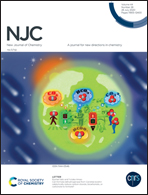Synthesis and characterization of new square planar heteroleptic cationic complexes [Ni(ii) β-oxodithioester-dppe]+; their use as a catalyst for Chan–Lam coupling†
Abstract
Novel heteroleptic [Ni(II) β-oxodithioester-dppe]+PF6− complexes (β-oxodithioester = methyl-3-hydroxy-3-benzyl-2-propenedithioate L1 1, methyl-3-hydroxy-3-(p-methoxyphenyl)-2-propenedithioate L2 2, methyl-3-hydroxy-3-(naphthyl)-2-propenedithioate L3 3, methyl-3-hydroxy-3-(p-chlorophenyl)-2-propenedithioate L4 4, methyl-3-hydroxy-3-(p-bromophenyl)-2-propenedithioate L5 5 and methyl-3-hydroxy-3-(p-cyanophenyl)-2-propenedithioate L6 6) have been synthesized and characterized by elemental (C, H, N) analysis, ESI-MS, IR, UV-visible, 1H, 13C{1H}, 31P{1H} and 19F{1H} NMR spectroscopy. The distorted square planar structures of the isomorphous cationic complexes 2, 3, 4 and 5 have been determined by X-ray crystallography. The catalytic activities of 1–6 were investigated for the Chan–Lam coupling reaction involving arylboronic acids and amines to afford N-arylated products in good to excellent yields under mild conditions with 1 mol% catalyst loading. This catalytic protocol offers significant functional group tolerance, and is endowed with a broad substrate scope.
![Graphical abstract: Synthesis and characterization of new square planar heteroleptic cationic complexes [Ni(ii) β-oxodithioester-dppe]+; their use as a catalyst for Chan–Lam coupling](/en/Image/Get?imageInfo.ImageType=GA&imageInfo.ImageIdentifier.ManuscriptID=D0NJ01139H&imageInfo.ImageIdentifier.Year=2020)


 Please wait while we load your content...
Please wait while we load your content...